晶硅组件检测与分析
晶体硅电池组件在不同地域的性能分析
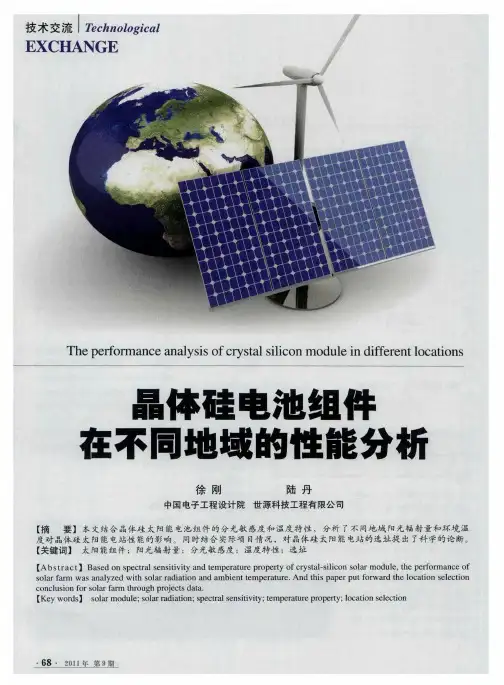
分类
辐 射类型
( W l" ・v) k vm
度相对较低 ,空气流动通畅。以甘肃敦煌为例 ,该地区年平 均气温在 9 5  ̄2  ̄ 间,晶体硅太阳能 电池受到工作温度 C之
我 国 西 部 ( 藏 、 青 西
一
类
直 射
l6~ 30 8 024 海 甘肃 、新疆等 )
升高影响造成 的发电损耗 为 2 左右 ( % 峰值功率温度系数 :
1% 5 ,太阳能发 电设备总安装容量达 2 G ) 0 W ,该计划必将推 动太阳能发 电产业 的进一步发展 。 目前太阳能 电站还 以晶 体硅 电池光伏 电站为主导, 该产业仍属政策推动型产业, 掌 握并 了解 晶体硅 电池组件的发 电性能 ,成 为项 目选 址的关
键。
Zr / m i
晶体硅太 阳能电池 的温度特性 一般用温度系数表示 。温度
系数 小说明即使温 度较高,但 转换效率变 化较 小 。
影响其发电的 自然条件
影响太 阳能光 伏 电站 的 自然条件主 要有太 阳能辐射 强度 、 空气质量 、空气温湿度 、周边遮挡物等 因素,其中平均辐射量 和环 境温度尤 为重要。
时 相 对 应 的 环境 温 度 约 为 2 ℃ 。 由于 太 阳 能 电池 板 工 作温 度 与 5 环 境 温 度 存 在 一 定相 对 关 系 , 因此 环 境 温 度 在 一 定 程 度 上 制 约 了太 阳 能 电池 的 效 能 。
0 7% . 5 左右 ( 峰值功率温度 系数:一 . % K 。综合考虑其它 04/) 因素,蒙西地 区太 阳能 电站年发 电量约为 10 k h k p 20W/W 。
南
3 2二类地 区 .
二类地 区太 阳能辐射资源丰 富, 以直接辐射 能为主。 不可利用 的辐射能 占 1%左右 。该类地区环境温度相对较 0 低 。以蒙西为例 ,该地区年气温波动在 1  ̄2  ̄ 2 2 C之间,晶 体硅太阳能 电池受到工作温度 升高影响造成 的发 电损耗为
晶体硅光伏组件EL测试的缺陷分析
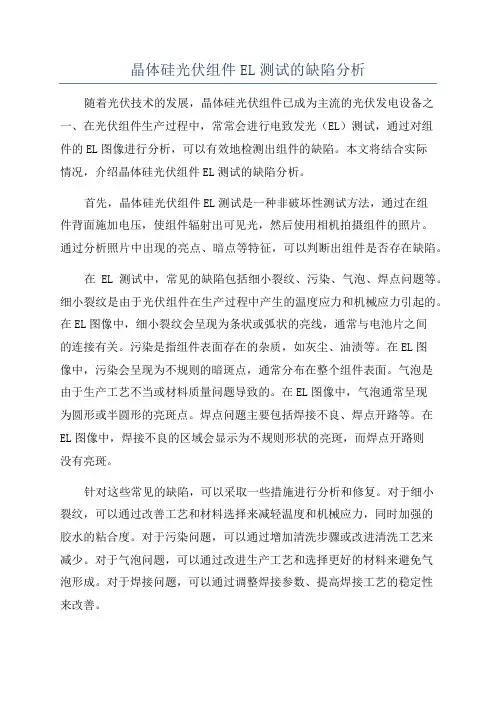
晶体硅光伏组件EL测试的缺陷分析随着光伏技术的发展,晶体硅光伏组件已成为主流的光伏发电设备之一、在光伏组件生产过程中,常常会进行电致发光(EL)测试,通过对组件的EL图像进行分析,可以有效地检测出组件的缺陷。
本文将结合实际情况,介绍晶体硅光伏组件EL测试的缺陷分析。
首先,晶体硅光伏组件EL测试是一种非破坏性测试方法,通过在组件背面施加电压,使组件辐射出可见光,然后使用相机拍摄组件的照片。
通过分析照片中出现的亮点、暗点等特征,可以判断出组件是否存在缺陷。
在EL测试中,常见的缺陷包括细小裂纹、污染、气泡、焊点问题等。
细小裂纹是由于光伏组件在生产过程中产生的温度应力和机械应力引起的。
在EL图像中,细小裂纹会呈现为条状或弧状的亮线,通常与电池片之间的连接有关。
污染是指组件表面存在的杂质,如灰尘、油渍等。
在EL图像中,污染会呈现为不规则的暗斑点,通常分布在整个组件表面。
气泡是由于生产工艺不当或材料质量问题导致的。
在EL图像中,气泡通常呈现为圆形或半圆形的亮斑点。
焊点问题主要包括焊接不良、焊点开路等。
在EL图像中,焊接不良的区域会显示为不规则形状的亮斑,而焊点开路则没有亮斑。
针对这些常见的缺陷,可以采取一些措施进行分析和修复。
对于细小裂纹,可以通过改善工艺和材料选择来减轻温度和机械应力,同时加强的胶水的粘合度。
对于污染问题,可以通过增加清洗步骤或改进清洗工艺来减少。
对于气泡问题,可以通过改进生产工艺和选择更好的材料来避免气泡形成。
对于焊接问题,可以通过调整焊接参数、提高焊接工艺的稳定性来改善。
需要注意的是,EL测试虽然能够有效地检测出组件的缺陷,但并不能判断缺陷对组件性能的具体影响。
因此,在EL测试结果出现异常时,需要进一步进行其他测试来评估组件的性能和质量。
总之,晶体硅光伏组件EL测试是一种重要的缺陷分析方法,通过对EL图像的分析,可以有效地检测出组件的缺陷,为组件生产和质量控制提供有力的支持。
通过对常见的缺陷进行分析和修复措施的探讨,可以进一步提高光伏组件的质量和性能。
晶体硅电池组件EL缺陷汇总及分析报告课件

学习交流PPT
10
缺陷种类九:过焊片
电池片过焊一般是在焊接工序产生的,过焊会造成电 池部分电流的收集障碍,该缺陷发生在主栅线的旁边。 成像特点是在EL图像下,黑色阴影部分从主栅线边缘延 副栅线方向整齐延伸。栅线外侧区域,一般为全黑阴影。 栅线之间一种是全黑 阴影,一种是由深至 浅的过渡阴影。我们 通过计算黑色区域的 面积来判定缺陷的级 别。
学习交流PPT
2
缺陷种类一:黑心片
EL照片中黑心片是反映在通电情况下电池片中心一圈 呈现黑色区域,该部分没有发出1150nm的红外光,故 红外相片中反映出黑心,此类发光现象和硅衬底少数载 流子浓度有关。这种电池片中心部位的电阻率偏高。
学习交流PPT
3
缺陷种类二:黑团片
多晶电池片黑团主要是由于硅片供应商一再缩短晶体 定向凝固时间,熔体潜热释放与热场温度梯度失配导致 硅片内部位错缺陷。
学习交流PPT
24
其他原因
8.组件扒皮返修过程中人员用力按压电池片也极易造 成破片。 9.层叠工序5S较差时异物吸附到组件内经过层压机层 压产生破片。 10.层压件堆放在托盘上超过规定数量或是运输过程中 颠簸均有可能导致电池片隐裂纹。 11.摔组件更是导致隐裂纹的罪魁祸首
学习交流PPT
25
总结
对于我们组件制造环节来讲EL不良总体可以分为两 大类即来料原因和后期人为原因。虽然电池片的好坏 我们无法掌控,但是我们每个工序都可以做到及时发 现及时反馈,不让不良电池片流入下一道工序,同时 将不良电池片退回供应商以减少我们的损失。
晶体硅电池组件EL缺陷汇总及 原因分析报告
学习交流PPT
1
EL检测原理
EL检测仪,又称太阳能组件电致发光缺陷检测仪,是 跟据硅材料的电致发光原理对组件进行缺陷检测及生产 工艺监控的专用测试设备。给晶体硅电池组件正向通入 1-1.5倍Isc的电流后硅片会发出1000-1100nm的红外光, 测试仪下方的摄像头可以捕捉到这个波长的光并成像于 电脑上。因为通 电发的光与PN结中离 子浓度有很大的关系, 因此可以根据图像来 判断硅片内部的状况。
晶硅太阳能电池组件—背板材料 产品技术 原材料 测试方法及质量问题
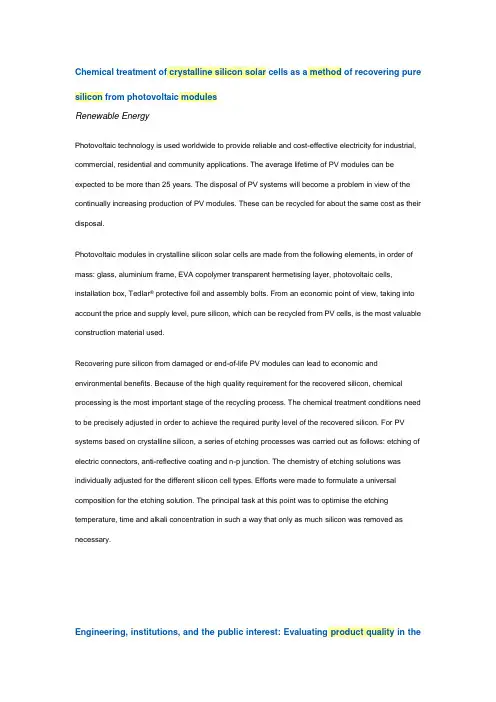
Chemical treatment of crystalline silicon solar cells as a method of recovering pure silicon from photovoltaic modulesRenewable EnergyPhotovoltaic technology is used worldwide to provide reliable and cost-effective electricity for industrial, commercial, residential and community applications. The average lifetime of PV modules can be expected to be more than 25 years. The disposal of PV systems will become a problem in view of the continually increasing production of PV modules. These can be recycled for about the same cost as their disposal.Photovoltaic modules in crystalline silicon solar cells are made from the following elements, in order of mass: glass, aluminium frame, EVA copolymer transparent hermetising layer, photovoltaic cells, installation box, Tedlar® protective foil and assembly bolts. From an economic point of view, taking into account the price and supply level, pure silicon, which can be recycled from PV cells, is the most valuable construction material used.Recovering pure silicon from damaged or end-of-life PV modules can lead to economic and environmental benefits. Because of the high quality requirement for the recovered silicon, chemical processing is the most important stage of the recycling process. The chemical treatment conditions need to be precisely adjusted in order to achieve the required purity level of the recovered silicon. For PV systems based on crystalline silicon, a series of etching processes was carried out as follows: etching of electric connectors, anti-reflective coating and n-p junction. The chemistry of etching solutions was individually adjusted for the different silicon cell types. Efforts were made to formulate a universal composition for the etching solution. The principal task at this point was to optimise the etching temperature, time and alkali concentration in such a way that only as much silicon was removed as necessary.Engineering, institutions, and the public interest: Evaluating product quality in theKenyan solar photovoltaics industryEnergy PolicySolar sales in Kenya are among the highest per capita among developing countries. While this commercial success makes the Kenya market a global leader, product quality problems have been a persistent concern. In this paper, we report performance test results from 2004 to 2005 for five brands of amorphous silicon (a-Si) photovoltaic (PV) modules sold in the Kenya market. Three of the five brands performed well, but two performed well below their advertised levels. These results support previous work indicating that high-quality a-Si PV modules are a good economic value. The presence of the low performing brands, however, confirms a need for market institutions that ensure the quality of all products sold in the market. Prior work from 1999 indicated a similar quality pattern among brands. This confirms the persistent nature of the problem, and the need for vigilant, long-term approaches to quality assurance for solar markets in Kenya and elsewhere. Following the release of our 2004/2005 test results in Kenya, the Kenya Bureau of Standards moved to implement and enforce performance standards for both amorphous and crystalline silicon PV modules. This appears to represent a positive step towards the institutionalization of quality assurance for products in the Kenya solar market.Electrical performance results from physical stress testing of commercial PV modules to the IEC 61215 test sequenceSolar Energy Materials and Solar CellsThis paper presents statistical analysis of the behaviour of the electrical performance of commercial crystalline silicon photovoltaic (PV) modules tested in the Solar Test Installation of the European Commission's Joint Research Centre from 1990 up to 2006 to the IEC Standard 61215 and its direct predecessor CEC Specification 503. A strong correlation between different test results was not observed, indicating that the standard is a set of different, generally independent stress factors. The results confirm the appropriateness of the testing scheme to reveal different module design problems related rather to the production quality control than material weakness in commercial PV modules.Efficiency model for photovoltaic modules and demonstration of its application to energy yield estimationA new method has been proposed [W. Durisch, K.H. Lam, J. Close, Behaviour of a copper indium gallium diselenide module under real operating conditions, in: Proceedings of the World Renewable Energy Congress VII, Pergamon Press, Oxford, Elsevier, Amsterdam, 2002, ISBN 0-08-044079-7] for the calculation of the annual yield of photovoltaic (PV) modules at selected sites, using site-specific meteorological data. These yields are indispensable for calculating the expected cost of electricity generation for different modules, thus allowing the type of module to be selected with the highest yield-to-cost ratio for a specific installation site. The efficiency model developed and used for calculating the yields takes three independent variables into account: cell temperature, solar irradiance and relative air mass. Open parameters of the model for a selected module are obtained from current/voltage (I/V) characteristics, measured outdoors at Paul Scherrer Institute's test facility under real operating conditions.From the model, cell and module efficiencies can be calculated under all relevant operating conditions. Yield calculations were performed for five commercial modules (BP Solar BP 585 F, Kyocera LA361K54S, Uni-Solar UPM-US-30, Siemens CIS ST40 and Wuerth WS11003) for a sunny site in Jordan (Al Qawairah) for which reliable measured meteorological data are available. These represent mono-crystalline, poly-crystalline and amorphous silicon as well as with copper–indium-diselenide, CuInSe2 PV modules. The annual yield for these modules will be presented and discussed.Experimental validation of crystalline silicon solar cells recycling by thermal and chemical methodsIn recent years, photovoltaic power generation systems have been gaining unprecedented attention as an environmentally beneficial method for solving the energy problem. From the economic point of view pure silicon, which can be recovered from spent cells, is the most important material owing to its cost and limited supply.The article presents a chemical method for recycling spent or damaged modules and cells, and the results of its experimental validation.The recycling of PV cells consists of two main steps: the separation of cells and their refinement. Cells are first separated thermally or chemically; the separated cells are then refined. During this process the antireflection, metal coating and p–n junction layers are removed in order to recover the silicon base, ready for its next use. This refinement step was performed using an optimised chemical method. Silicon wafers were examined with an environmental scanning electron microscope (ESEM) coupled to an EDX spectrometer.The silicon wafers were used for producing new silicon solar cells, which were then examined and characterized with internal spectral response and current–voltage characteristics. The new cells, despite the fact that they have no SiN x antireflective coating, have a very good efficiency of 13–15%.The impact of silicon feedstock on the PV module costThe impact of the use of new (solar grade) silicon feedstock materials on the manufacturing cost of wafer-based crystalline silicon photovoltaic modules is analyzed considering effects of material cost, efficiency of utilisation, and quality. Calculations based on data provided by European industry partners are presented for a baseline manufacturing technology and for four advanced wafer silicon technologies which may be ready for industrial implementation in the near future. Iso-cost curves show the technologyparameter combinations that yield a constant total module cost for varying feedstock cost, silicon utilisation, and cell efficiency. A large variation of feedstock cost for different production processes, from near semiconductor grade Si (30 €/kg) to upgraded metallurgical grade Si (10€/kg), changes the cost of crystalline silicon modules by 11% for present module technologies or by 7% for advanced technologies, if the cell efficiency can be maintained. However, this cost advantage is completely lost if cell efficiency is reduced, due to quality degradation, by an absolute 1.7% for present module technology or by an absolute 1.3% for advanced technologies.Thin-film monocrystalline-silicon solar cells made by a seed layer approach on glass-ceramic substratesSolar modules made from thin-film crystalline-silicon layers of high quality on glass substrates could lower the price of photovoltaic electricity substantially. One way to create crystalline-silicon thin films on non-silicon substrates is to use the so-called “seed layer approach”, in which a thin crystalline-silicon seed layer is first created, followed by epitaxial thickening of this seed layer.In this paper, we present the first solar cell results obtained on 10-μm-thick monocrystalline-silicon (mono-Si) layers obtained by a seed layer approach on transparent glass-ceramic substrates. The seed layers were made using implant-induced separation and anodic bonding. These layers were then epitaxially thickened by thermal CVD. Simple solar cell structures without integrated light trapping features showed efficiencies of up to 7.5%. Compared to polycrystalline-silicon layers made by aluminum-induced crystallization of amorphous silicon and thermal CVD, the mono-Si layers have a much higher bulk diffusion lifetime.Waved glass: Towards optimal light distribution on solar cell surfaces for high efficient modulesA method to improve the module efficiency of solar cells by modifying the surface of the glass cover of the solar cells module is proposed. A model is built to show that a better efficiency can be achieved by optimizing the light distribution on the cell, which reduces the shadow losses and thereby allows the finger spacing to be decreased, which in turn decreases the (resistive) ohmic losses.This method is illustrated by considering industrial crystalline silicon solar cells as an example, however, it applies to all solar cells that are characterized by a metallization pattern on the surface of the solar cell. It is estimated that this method can improve the relative module efficiency by about 5% and halve the front side losses.Analysis of series resistance of crystalline silicon solar cell with two-layer front metallization based on light-induced platingImproving the front metallization quality of silicon solar cells should be a key to enhance cell performance. In this work, we investigated a two-layer metallization scheme involving light-induced plating (LIP) and tried to quantify its impact on the series resistance of the front grid metals and FFs on finished cells. To estimate the effect of LIP processing on a printed and fired seed layer, individual components of series resistance were measured before and after LIP processing. Among them, grid resistance and contact resistance were closely observed because of their large contribution to series resistance. To optimize the plating on the seed metal grid, the grid resistance of the two-layer metal grid structure was calculated as a function of cross section area of the plated layer. Contact resistivity of the grid before and after LIP processing was analyzed to understand the contact resistance reduction, as well. As a result, the efficiency of solar cells with 80 μm seed metal grid width increased by 0.3% absolute compared with conventional solar cells of 120 μm metal grid width. The total area of electrodes in conventional cells was 1800 mm2 and electrodes area of LIP processed solar cells was 1400 mm2. The efficiency gain was due to reduction of shadowing loss from 7.7% to 6.0% without the increase of resistance due to two-layer front metallization.Simulation of hetero-junction silicon solar cells with AMPS-1DMono- and poly-crystalline silicon solar cell modules currently represent between 80% and 90% of the PV world market. The reasons are the stability, robustness and reliability of this kind of solar cells as compared to those of emerging technologies. Then, in the mid-term, silicon solar cells will continue playing an important role for their massive terrestrial application. One important approach is the development of silicon solar cells processed at low temperatures (less than 300 °C) by depositing amorphous silicon layers with the purpose of passivating the silicon surface, and avoiding the degradation suffered by silicon when processed at temperatures above 800 °C. This kind of solar cells is known as HIT cells (hetero-junction with an intrinsic thin amorphous layer) and are already produced commercially (Sanyo Ltd.), reaching efficiencies above 20%. In this work, HIT solar cells are simulated by means of AMPS-1D, which is a program developed at Pennsylvania State University. We shall discuss the modifications required by AMPS-1D for simulating this kind of structures since this program explicitly does not take into account interfaces with high interfacial density of states as occurs at amorphous-crystalline silicon hetero-junctions.太阳能硅电池的软件仿真设计与制造Mapping the performance of PV modules, effects of module type and data averaging统计实验与数据收集处理:太阳能发电电池背板组件模块的效用与背板材料开发方向选取Solar EnergyA method is presented for estimating the energy yield of photovoltaic (PV) modules at arbitrary locations in a large geographical area. The method applies a mathematical model for the energy performance of PV modules as a function of in-plane irradiance and module temperature and combines this with solar irradiation estimates from satellite data and ambient temperature values from ground station measurements. The method is applied to three different PV technologies: crystalline silicon, CuInSe2 and CdTe based thin-film technology in order to map their performance in fixed installations across most of Europe and to identify and quantify regional performance factors. It is found that there is a clear technology dependence of the geographical variation in PV performance. It is also shown that using long-term average values of irradiance and temperature leads to a systematic positive bias in the results of up to 3%. It is suggested to use joint probability density functions of temperature and irradiance to overcome this bias.Outdoor performance evaluation of photovoltaic modules using contour plots户外太阳能电池背板发电效果/转化率评估评价Current Applied PhysicsThe impact of environmental parameters on different types of Si-based photovoltaic (PV) modules (single crystalline Si (sc-Si), amorphous Si (a-Si) and a-Si/ microcrystalline Si (μc-Si)) which have different spectral responses were characterized using contour plots. The contour plots of PV performance as a function of module temperature and spectral irradiance distribution were created to separate the impact of the two environmental parameters. The performance of the sc-Si PV module was dominated by the module temperature while those of a-Si and a-Si/μc-Si ones were mainly influenced by the spectral irradiance distribution. Furthermore, the frequency of outdoor conditions and the reliability of the contour plots of the PV performance were discussed for the evaluation of PV modules by means of energy production.最新应用物理学学报Solar photovoltaic charging of lithium-ion batteries太阳能——锂电池充电器Power SourcesSolar photovoltaic (PV) charging of batteries was tested by using high efficiency crystalline and amorphous silicon PV modules to recharge lithium-ion battery modules. This testing was performed as a proof of concept for solar PV charging of batteries for electrically powered vehicles. The iron phosphate type lithium-ion batteries were safely charged to their maximum capacity and the thermal hazards associated with overcharging were avoided by the self-regulating design of the solar charging system. The solar energy to battery charge conversion efficiency reached 14.5%, including a PV systemefficiency of nearly 15%, and a battery charging efficiency of approximately 100%. This high system efficiency was achieved by directly charging the battery from the PV system with no intervening electronics, and matching the PV maximum power point voltage to the battery charging voltage at the desired maximum state of charge for the battery. It is envisioned that individual homeowners could charge electric and extended-range electric vehicles from residential, roof-mounted solar arrays, and thus power their daily commuting with clean, renewable solar energy.Selective ablation with UV lasers of a-Si:H thin film solar cells in direct scribing configuration材料配比方案与实验选择配置方法Applied Surface Science 应用表面材料科学学报Monolithical series connection of silicon thin-film solar cells modules performed by laser scribing plays a very important role in the entire production of these devices. In the current laser process interconnection the two last steps are developed for a configuration of modules where the glass is essential as transparent substrate. In addition, the change of wavelength in the employed laser sources is sometimes enforced due to the nature of the different materials of the multilayer structure which make up the device. The aim of this work is to characterize the laser patterning involved in the monolithic interconnection process in a different configuration of processing than the usually performed with visible laser sources. To carry out this study, we use nanosecond and picosecond laser sources working at 355 nm of wavelength in order to achieve the selective ablation of the material from the film side. To assess this selective removal of material has been used EDX (Energy Dispersive Using X-Ray) analysis, electrical measurements and confocal profiles. In order to evaluate the damage in the silicon layer, Raman spectroscopy has been used for the last laser process step. Raman spectra gives information about the heat affected zone in the amorphous silicon structure through the crystalline fraction calculation. The use of ultrafast sources, such as picoseconds lasers, coupled with UV wavelength gives the possibility to consider materials and substrates different than currently used, making the process more efficient and easy to implement in production lines. This approach with UV laser sources working from the film side offers no restriction in the choice of materials which make up the devices and the possibility to opt for opaque substrates. Keywords: laser scribing; selective ablation; a-Si:H.Use of digital image correlation technique to determine thermomechanical deformations in photovoltaic laminates: Measurements and accuracy数字化图像匹配技术在太阳能材料评估实验中的应用:决策准确性的提高Solar Energy Materials and Solar Cells 太阳能材料与电磁学报An experimental technique to measure the deformation of solar cells in transparent PV modules is presented. This method uses the digital image correlation technique with a stereo camera system. Deformations resulting from thermal loading, where rather small deformations occur compared to tensile or bending experiments, are measured by viewing through the window of a climate chamber. We applythis method to measure the thermomechanical deformation of the gap between two crystalline silicon solar cells by viewing through the transparent back sheet of the laminate. Two PV laminates are prepared, each with three crystalline silicon solar cells that are embedded in transparent polymer sheets on a glass substrate. The first laminate (A) contains non-interconnected cells while the second laminate consists of a standard-interconnected cell string (B). We find the gap between two solar cells to deform 66.3±2 μm between 79.6 and −17.3 °C (laminate A) and 66.4±2 μm (laminate B) between 84.4 and −39.1 °C. We determine an accuracy of 1 μm in displacement for the gap experiment by measuring free expansion of a copper strip and averaging displacement values over regions with homogeneous deformation. Furthermore, the relative error contribution in strain due to the optical influence of the layers on top of the object surface is less than 1×10−6 for one camera. This is proven by a geometrical consideration.Nanostructure, electrical and optical properties of p-type hydrogenated nanocrystalline silicon films太阳能发电产氢系统应用中,硅薄膜/贴膜的特性、形态及其性能优化VacuumIn this paper, p-type hydrogenated nanocrystalline (nc-Si:H) films were prepared on corning 7059 glass by plasma-enhanced chemical vapor deposition (PECVD) system. The films were deposited with radio frequency (RF) (13.56 MHz) power and direct current (DC) biases stimulation conditions. Borane (B2H6) was a doping agent, and the flow ratio ηof B2H6component to silane (SiH4) was varied in the experimental. Films’ surface morphology was investigated with atomic force microscopy (AFM); Raman spectroscopy, X-ray diffraction (XRD) was performed to study the crystalline volume fraction Xc and crystalline size d in films. The electrical and optical properties were gained by Keithly 617 programmable electrometer and ultraviolet-visible (UV-VIS) transmission spectra, respectively. It was found that: there are on the film surface many faulty grains, which formed spike-like clusters; increasing the flow ratio η, crystalline volume fraction Xc decreased from 40.4 % to 32.0 % and crystalline size d decreased from 4.7 to 2.7nm; the optical band gap E g opt increased from 2.16 to 2.4eV. The electrical properties of p-type nc-Si:H films are affected by annealing treatment and the reaction pressure.。
与地面用晶体硅光伏组件环境适应性评价相关的测试方法
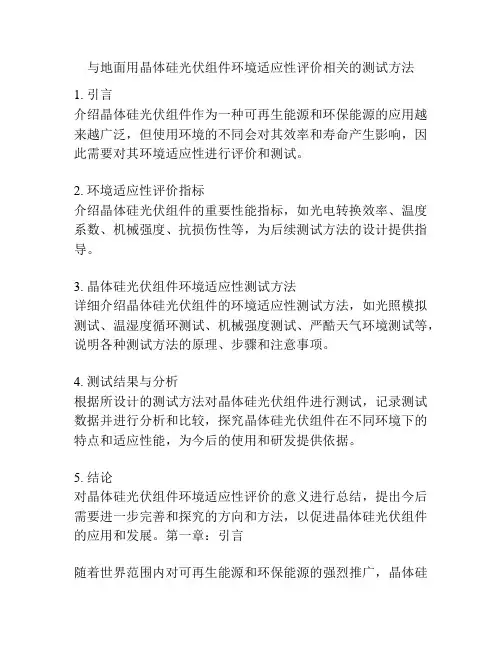
与地面用晶体硅光伏组件环境适应性评价相关的测试方法1. 引言介绍晶体硅光伏组件作为一种可再生能源和环保能源的应用越来越广泛,但使用环境的不同会对其效率和寿命产生影响,因此需要对其环境适应性进行评价和测试。
2. 环境适应性评价指标介绍晶体硅光伏组件的重要性能指标,如光电转换效率、温度系数、机械强度、抗损伤性等,为后续测试方法的设计提供指导。
3. 晶体硅光伏组件环境适应性测试方法详细介绍晶体硅光伏组件的环境适应性测试方法,如光照模拟测试、温湿度循环测试、机械强度测试、严酷天气环境测试等,说明各种测试方法的原理、步骤和注意事项。
4. 测试结果与分析根据所设计的测试方法对晶体硅光伏组件进行测试,记录测试数据并进行分析和比较,探究晶体硅光伏组件在不同环境下的特点和适应性能,为今后的使用和研发提供依据。
5. 结论对晶体硅光伏组件环境适应性评价的意义进行总结,提出今后需要进一步完善和探究的方向和方法,以促进晶体硅光伏组件的应用和发展。
第一章:引言随着世界范围内对可再生能源和环保能源的强烈推广,晶体硅光伏组件作为一种十分重要的能源转换和利用技术已经得到了广泛的应用。
晶体硅光伏组件作为一种新型的绿色能源设备,能够将太阳光能充分利用,将光能转化成为电能,其应用范围非常广泛,主要可应用于住宅、商用、工业大楼等多个领域。
然而,由于晶体硅光伏组件的使用环境存在着较大的差异,如温度、湿度、风力、光照强度等因素会对其效率和寿命产生不同程度的影响。
因此,需要对晶体硅光伏组件的环境适应性进行评价和测试,以更好地了解其性能和可靠性,并为其推广和应用提供科学的依据。
本文将从晶体硅光伏组件环境适应性的基本概念开始,介绍该领域的相关调研现状和研究成果,然后进一步探究晶体硅光伏组件环境适应性评价的指标、测试方法和结果分析等方面,为晶体硅光伏组件的应用和发展提供理论依据和实践经验。
第二章:环境适应性评价指标晶体硅光伏组件作为一种重要的可再生能源装置,其性能指标决定了它的光电转换效率和使用寿命。
光伏组件的检验测试(终检)
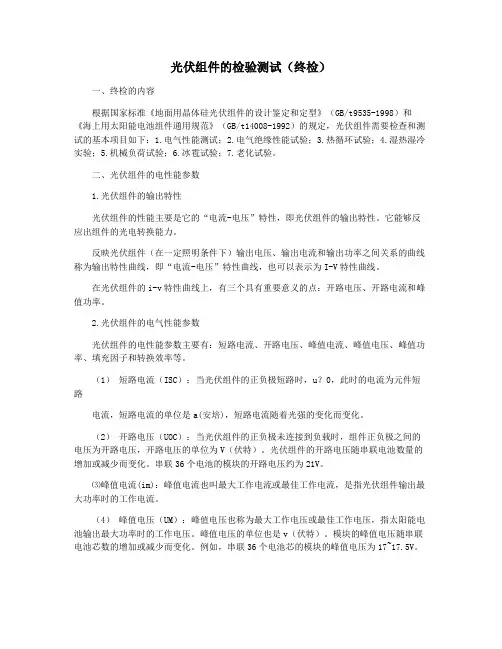
光伏组件的检验测试(终检)一、终检的内容根据国家标准《地面用晶体硅光伏组件的设计鉴定和定型》(GB/t9535-1998)和《海上用太阳能电池组件通用规范》(GB/t14008-1992)的规定,光伏组件需要检查和测试的基本项目如下:1.电气性能测试;2.电气绝缘性能试验;3.热循环试验;4.湿热湿冷实验;5.机械负荷试验;6.冰雹试验;7.老化试验。
二、光伏组件的电性能参数1.光伏组件的输出特性光伏组件的性能主要是它的“电流-电压”特性,即光伏组件的输出特性。
它能够反应出组件的光电转换能力。
反映光伏组件(在一定照明条件下)输出电压、输出电流和输出功率之间关系的曲线称为输出特性曲线,即“电流-电压”特性曲线,也可以表示为I-V特性曲线。
在光伏组件的i-v特性曲线上,有三个具有重要意义的点:开路电压、开路电流和峰值功率。
2.光伏组件的电气性能参数光伏组件的电性能参数主要有:短路电流、开路电压、峰值电流、峰值电压、峰值功率、填充因子和转换效率等。
(1)短路电流(ISC):当光伏组件的正负极短路时,u?0,此时的电流为元件短路电流,短路电流的单位是a(安培),短路电流随着光强的变化而变化。
(2)开路电压(UOC):当光伏组件的正负极未连接到负载时,组件正负极之间的电压为开路电压,开路电压的单位为V(伏特)。
光伏组件的开路电压随串联电池数量的增加或减少而变化。
串联36个电池的模块的开路电压约为21V。
⑶峰值电流(im):峰值电流也叫最大工作电流或最佳工作电流,是指光伏组件输出最大功率时的工作电流。
(4)峰值电压(UM):峰值电压也称为最大工作电压或最佳工作电压,指太阳能电池输出最大功率时的工作电压。
峰值电压的单位也是v(伏特)。
模块的峰值电压随串联电池芯数的增加或减少而变化。
例如,串联36个电池芯的模块的峰值电压为17~17.5V。
⑸峰值功率(pm):峰值功率也叫最大输出功率或最佳输出功率,是指光伏组件在正常工作或测试条件下的最大输出功率,也就是峰值电流与峰值电压的乘积:pm=im?um。
地面用晶体硅光伏组件设计鉴定和定型
地面用晶体硅光伏组件设计鉴定和定型摘要地面用晶体硅光伏组件是一种广泛应用于太阳能光伏发电系统中的重要组成部分。
本文主要介绍了地面用晶体硅光伏组件的设计、鉴定和定型的相关内容。
首先介绍了光伏组件的基本结构和工作原理,然后详细讨论了地面用晶体硅光伏组件的设计原则和注意事项。
接下来,介绍了光伏组件的鉴定方法和标准,包括性能参数测试、质量控制和可靠性评估。
最后,介绍了光伏组件的定型方法和流程,包括组件的封装、安装和接线等方面的技术要点。
希望通过本文的介绍,可以帮助读者对地面用晶体硅光伏组件的设计、鉴定和定型有一个全面的了解。
1. 引言地面用晶体硅光伏组件是太阳能光伏发电系统中的核心组件之一,其性能的优劣直接影响着整个光伏系统的发电效率和经济效益。
因此,地面用晶体硅光伏组件的设计、鉴定和定型显得尤为重要。
2. 光伏组件的基本结构和工作原理地面用晶体硅光伏组件由若干个光伏电池组成,电池之间通过连线和电连接件连接起来。
光伏电池常采用晶体硅材料,通过光照产生电能。
光伏组件的基本结构主要包括玻璃罩、背板、边框以及密封胶等组件。
工作原理是当太阳光照射到光伏电池上时,光子的能量被电池中的材料吸收,产生电子和空穴,从而形成光生电效应。
3. 地面用晶体硅光伏组件的设计原则和注意事项在设计地面用晶体硅光伏组件时,需要考虑以下几个主要原则和注意事项:3.1 光电转化效率地面用晶体硅光伏组件的设计目标是尽可能提高光电转化效率,以提高发电能力。
通过优化光伏电池的结构和材料,提高光伏组件的光吸收能力和电子收集效率,可以有效提高光电转化效率。
3.2 结构设计地面用晶体硅光伏组件的结构设计需要考虑组件的机械强度和稳定性。
合理选择玻璃罩、背板和边框的材料和结构,可以保证组件在户外环境下的长期稳定运行。
3.3 温度控制地面用晶体硅光伏组件在工作过程中会产生一定的热量,在高温条件下,组件的发电效率会下降。
因此,需要合理设计散热系统,控制组件的工作温度。
晶硅组件检测与分析
晶硅组件检测与分析This model paper was revised by the Standardization Office on December 10, 2020光伏电站晶硅组件如何检测与分析光伏电站的质量问题由来已久,几年前,一家权威认证机构对国内已经在运行的多座大型晶硅组件光伏电站进行了质量检测,调查发现光伏组件普遍存在各种质量问题,如热斑、隐裂和功率衰减等,对电站的发电量、KPI指标、电站收益及日常运行维护带来严重影响。
电站建成后,随着时间的推移,组件本身首年光致衰减及逐年衰减率和其他衰减因素都客观存在、不可避免,因此实际的装机容量会逐年减少,那么基于原始装机容量进行理论发电量或理论功率输出计算的发电性能指标如PR、CPR和EPI等,其中包含的光伏电池板自身损耗部分会逐年增加,而且实际装机容量的不确定性将对次年各个电站的计划发电量的制定带来一定影响。
因此文中基于现实存在的客观情况,着重探讨已并网电站的户外组件电性能测试及功率修正方法、组件热斑现象和原因分析以及晶硅组件PID功率衰减的快速甄别方法,由于篇幅有限,其他质量问题的检测将另起他文探讨。
通过相关的测试和分析手段,可对自有电站的实际情况有清楚的了解,如组件的衰减情况、热斑组件的分布比例及是否存在PID 组件等等。
一、组件(方阵)I-V测试及功率修正方法笔者曾在某西部多家地面电站进行考察,发现在某一随机时段各个逆变器的发电量存在较大差异。
如图1所示,通过对电站逐级逐段分析,排除了逆变器本身及对应方阵故障、设备停机等因素,发现电量差异的主要来源为各个组串工作电流的波动性,整体离散率较高,有的甚至超过20%。
逆变器发电量的差异和组件的功率输出情况有密切关联,因此有必要从汇流箱侧去查找低功率的组串或组件,一般的,户外组件或方阵组串的电性能测试使用便携式I-V测试仪,本部分首先介绍便携I-V测试仪的原理、配套辐照度计量仪的类型和特点,接着介绍现场组件功率测试的一次修正和二次修正方法。
晶体硅光伏组件认证测试耐候性项目失效分析的研究报告
晶体硅光伏组件认证测试耐候性项目失效分析的研究报告晶体硅光伏组件是太阳能光伏系统的重要组成部分,用于将太阳能转化为可使用的电能。
然而,由于光伏组件长期暴露在复杂的气候条件下,耐久性成为组件性能评估的一个重要指标。
因此,本研究旨在进行晶体硅光伏组件的耐候性测试和失效分析。
1.测试方法本研究采用了国际电工委员会(IEC)发布的IEC61215标准,对晶体硅光伏组件进行了耐候性测试,测试时间为1000小时。
测试过程采用蒸馏水雾化、高温高湿和低温循环等方式进行模拟气候环境,测试后对性能进行评估。
2.测试结果测试结果表明,晶体硅光伏组件经过1000小时的耐候性测试后,其性能指标出现了一定程度的下降。
特别是在高温高湿环境下,组件的输出电压、电流和功率均出现了不同程度的下降。
同时,组件的输出特性也发生了变化,出现了比较明显的损失。
3.失效分析从实验结果来看,晶体硅光伏组件的耐久性下降主要表现在以下几个方面:(1)光伏单元损失。
组件在高温高湿环境中容易引起光伏单元的损失,尤其是在高温条件下,单元的导电性能会大幅度下降,从而降低组件的输出能力。
(2)漏电导致的损失。
组件在经过1000小时的高湿环境测试后易产生漏电现象,漏电会导致组件内部产生热能,破坏组件内部结构从而导致失效。
(3)表面腐蚀。
组件在高温高湿和蒸馏水雾化的环境下易产生表面腐蚀,使组件表面光洁度降低,降低了组件的光吸收效率。
4.结论综合测试结果及失效分析,可以得出晶体硅光伏组件的耐久性存在失效的可能性,各种气候条件下对组件的影响有所不同。
因此,在使用晶体硅光伏组件时,需要注意其使用环境,定期对组件进行检测和维护,及时更换失效的组件。
同时,研究和改进组件的防潮、防晒等性能,提高组件的稳定性和可靠性,对于推广和应用光伏发电技术具有重要意义。
数据分析是研究报告中很重要的一部分,下面针对晶体硅光伏组件认证测试耐候性项目的数据进行分析。
根据测试,晶体硅光伏组件在1000小时的耐候性测试中出现了一定程度的下降。
多(单)晶硅太阳能电池组件,层压过程常见不良现象原因及分析
多(单)晶硅太阳能电池组件,层压过程常见不良现象原因及分析下面是实际生产中经常遇到的一些问题。
提出问题:1、组件中有碎片。
2、组件中有气泡。
3、组件中有毛发及垃圾。
4、汇流条向内弯曲。
5、组件背膜凹凸不平。
问题分析:1、组件中有碎片,可能造成的原因:1、由于在焊接过程中没有焊接平整,有堆锡或锡渣,在抽真空时将电池片压碎。
2、本来电池片都已经有暗伤,再加上层压过早,EVA 还具有很良好的流动性。
3、在抬组件的时候,手势不合理,双手已压到电池片。
2、组件中有气泡,可能造成的原因:1、EVA 已裁剪,放置时间过长,它已吸潮。
2、EVA 材料本身不纯。
3、抽真空过短,加压已不能把气泡赶出。
4、层压的压力不够。
5、加热板温度不均,使局部提前固化。
6、层压时间过长或温度过高,使有机过氧化物分解,产出氧气。
7、有异物存在,而湿润角又大于90°,使异物旁边有气体存在。
3、组件中有毛发及垃圾,可能造成的原因:1、由于EVA、DNP、小车子有静电的存在,把飘着空的头发,灰尘及一些小垃圾吸到表面。
2、叠成时,身体在组件上方作业,而又不能保证身体没有毛发及垃圾的存在。
3、一些小飞虫子死命的往组件中钻。
4、汇流条向内弯曲,可能造成的原因:1、在层压中,汇流条位置会聚集比较多的气体。
胶板往下压,把气体从组件中压出,而那一部分空隙就要由流动性比较好EVA 来填补。
EVA 的这种流动,就把原本直的汇流条压弯。
2、EVA 的收缩。
5、组件背膜凹凸不平,可能造成的原因:1、多余的EVA 会粘到高温布和胶板上。
问题解决:1、组件中有碎片:①、首先要在焊接区对焊接质量进行把关,并对员工进行一些针对性的培训,使焊接一次成型。
②、调整层压工艺,增加抽真空时间,并减小层压压力(通过层压时间来调整)。
③、控制好各个环节,优化层压人员的抬板的手势。
2、组件中有气泡:①、控制好每天所用的EVA 的数量,要让每个员工了解每天的生产任务。
②、材料是由厂家所决定的,所以尽量选择较好的材料。
- 1、下载文档前请自行甄别文档内容的完整性,平台不提供额外的编辑、内容补充、找答案等附加服务。
- 2、"仅部分预览"的文档,不可在线预览部分如存在完整性等问题,可反馈申请退款(可完整预览的文档不适用该条件!)。
- 3、如文档侵犯您的权益,请联系客服反馈,我们会尽快为您处理(人工客服工作时间:9:00-18:30)。
光伏电站晶硅组件如何检测与分析?光伏电站的质量问题由来已久,几年前,一家权威认证机构对国内已经在运行的多座大型晶硅组件光伏电站进行了质量检测,调查发现光伏组件普遍存在各种质量问题,如热斑、隐裂和功率衰减等,对电站的发电量、KPI指标、电站收益及日常运行维护带来严重影响。
电站建成后,随着时间的推移,组件本身首年光致衰减及逐年衰减率和其他衰减因素都客观存在、不可避免,因此实际的装机容量会逐年减少,那么基于原始装机容量进行理论发电量或理论功率输出计算的发电性能指标如PR、CPR和EPI等,其中包含的光伏电池板自身损耗部分会逐年增加,而且实际装机容量的不确定性将对次年各个电站的计划发电量的制定带来一定影响。
因此文中基于现实存在的客观情况,着重探讨已并网电站的户外组件电性能测试及功率修正方法、组件热斑现象和原因分析以及晶硅组件PID功率衰减的快速甄别方法,由于篇幅有限,其他质量问题的检测将另起他文探讨。
通过相关的测试和分析手段,可对自有电站的实际情况有清楚的了解,如组件的衰减情况、热斑组件的分布比例及是否存在PID组件等等。
一、组件(方阵)I-V测试及功率修正方法笔者曾在某西部多家地面电站进行考察,发现在某一随机时段各个逆变器的发电量存在较大差异。
如图1所示,通过对电站逐级逐段分析,排除了逆变器本身及对应方阵故障、设备停机等因素,发现电量差异的主要来源为各个组串工作电流的波动性,整体离散率较高,有的甚至超过20%。
逆变器发电量的差异和组件的功率输出情况有密切关联,因此有必要从汇流箱侧去查找低功率的组串或组件,一般的,户外组件或方阵组串的电性能测试使用便携式I-V测试仪,本部分首先介绍便携I-V测试仪的原理、配套辐照度计量仪的类型和特点,接着介绍现场组件功率测试的一次修正和二次修正方法。
图1 某地面电站某一时段各个逆变器的发电对比1.1便携式I-V测试仪分类与测试原理据调研目前市场上常用的便携式I-V测试仪主要有可变电子负载式和动态电容式两种,如图2和图3所示,可变电子负载式是仪器自身内置了电子负载,当电阻从0变到无穷大的时候,仪器通过采集上百个负载点所对应的工作电流和工作电压值来构成整条I-V曲线,并通过算法寻找到最大功率点。
电容式I-V测试仪以充电式动态电容作为光伏组件的动态负载,实际测试时,光伏组件因有光生电流对电容充电,电容在开始充电时,阻抗很低几乎为零,充电回路相当于短路,当充电结束,阻抗非常高,充电回路相当于开路,那么在电容的充电过程中,电容的阻抗从0变到无穷大,相当于光伏组件或阵列的负载电阻从0变化到无穷大,然后对电压电流进行采样,这些采样点构成了光伏组件的I-V特性曲线。
和可变电子负载式相比,动态电容式测试方法的优点是虽然测试速度较快,精度较高,但需要复杂的控制电路,而对于阵列型的I-V测试仪,就需要比较大的电容器,那么体积和重量就会增加,所以带到户外进行测试会比较笨重。
图2 可变电子负载式图3 动态电容式1.2 太阳辐照数据采集介绍便携式I-V测试仪在测试过程中需要对实时的辐照数据进行采集,辐照采集目前常用的仪器是总辐射表,它分为热电型(Thermopile Pyranometers)和光电型(Silicon Pyranometers)两种,如图4所示为热电型,图5为光电型。
热电型一般为两层玻璃罩结构,由玻璃罩下黑色感应面与内部的热电堆等感应器件组成。
一般感应元件表面涂有高吸收率的黑色涂层,感应元件的热接点在感应面上,而冷接点位于仪器的机体内,双层石英玻璃罩结构的作用是防止热接点单方向通过玻璃罩与环境进行热交换,提高测量精度。
同时为了避免太阳辐射对冷接点的影响,增加了一个白色防辐射盘用来反射阳光的热辐射。
它的原理很简单,当太阳辐射透过玻璃罩到达热电表感应面时,冷热结点会产生温差,由此产生温差电动势,将光信号转换为电信号输出,那么这个输出信号与感应面上所接收到的太阳辐照度成正比(在线性误差范围内),根据毫伏表或电位差计测出的热电势就可以进行读数。
目前光电型辐照计一般使用硅光电二极管传感器,也有使用标准太阳电池(Reference cells)作为辐照度传感器件,它的原理是利用其短路电流与投射在电池片上的太阳辐照度的线性关系来测定太阳辐照度,分为电压输出型和电流输出型两种,对于电流输出型,一般可在电路设计上增加小的负载电阻,通过测量负载电阻之间的电压来间接得到短路电流。
图4 热电表(热电堆型)2图5 光电型辐照计(晶硅电池片式)当前我国的太阳辐射观测网所选用的总辐射表大部分都是热电型,热电型总辐射表的光谱范围较宽,一般大致为太阳全谱段的280nm至3000 nm(参考图6,来源于荷兰Kipp&Zonen公司),响应时间一般小于60s,价格较高。
而光电型总辐射表的光谱范围大致为400nm至1100nm,响应时间一般小于10μs,其光谱响应范围与太阳能电池板的工作光谱范围十分接近,且主要特点是其响应时间快、价格低廉。
因此光电表的光谱选择性完全取决于其自身的光电感应器件硅光电二极管(含标准电池),具有一定的光谱选择特性,而热电表中的热电堆,属于中性宽带感应器件,并没有明显的光谱选择性。
图6 光谱响应曲线(蓝色:太阳辐射光谱绿色:晶硅电池片的光谱响应红色:热电表的光谱响应)表1为两者的特点对比,其中温度特性是环境温度发生改变后,表的灵敏度所发生的变化。
光电表一般都没有温度补偿电路,因此需要在实际使用中确定光电表观测数据的温度系数进行补偿。
由于在测量过程中的温度变化引入的测量偏差较大,热电型则拥有质量更高的玻璃罩,对温度变化所做的温度修正精度也更高。
一般来说,热电型总辐射表主要用来测量水平面太阳总辐射,也可用来测量入射到方阵斜面上的太阳总辐射,因此在评价电站的PR能效比和EPI一般采用热电表来计量方阵斜面总辐射量(POA),而由于光电表的光谱响应和电池的光谱响应较为接近,所以光伏组件或方阵的实时输出功率测试可使用光电表。
但是电池片型光电表也存在一些问题,如电池片的衰减特性、易受环境污染和温度影响、余弦误差和方向误差偏高、校准难度大、以及测量精度和电池片封装玻璃的透射率都有关系等,特别是光电表的温度修正、余弦误差和方位误差的测量和控制在校准的时候需要注意的。
表1 两种辐射表的特点对比1.3 组件背板温度采集组件背板温度数据的采集操作有下面两种,图7为胶带粘接式测试,其探头分为金属或者环氧树脂探头,图8为吸盘式。
一般情况下,若温度数据的采集精度不够,还需使用高精度IR热成像仪进行辅助测试以确定实际的组件背板温度,需要注意的一点是很多厂家将背板温度当成电池片的结温,这是不正确的,根据美国Sandia实验室的经验值,一般地面电站上的晶硅电池片结温在组件背板温度值的基础上再加上2℃-3℃。
或者也可以根据国标《GBT18210-2000 晶体硅光伏方阵I—V特性的现场测量》推荐的开路电压法来推算结温,但是其过程较为繁琐,不适用于实际户外操作。
图7 胶带粘贴式测试(环氧树脂探头)图8 吸盘式温度传感器探头1.4 功率测试值的修正方法便携式I-V曲线测试仪可以测试单片组件、组串和单台汇流箱直流电路的I-V曲线。
一般仪器自身也可以将实际自然光照条件下的实测功率数据进行自动修正,即修正到标准测试条件(STC)下的峰值功率。
测试仪修正的内容为温度和光强这两项修正,并未考虑到实际组件的灰尘遮挡损失、组串匹配损失及仪器自身的测试精度,另外如果在汇流箱的输入端进行测量,方阵的各个组串到达汇流箱的线缆长度不尽相同,也会存在电缆损耗,同样影响对组件或方阵真实功率的判断,因此还需要进行第二次修正,将上述损耗补偿到实际功率值当中,具体参考如下几点:1.灰尘遮蔽损失补偿损失Ls需要根据电站所处的地理位置和自然环境,测试期间天气状况及组件表面积灰状况,可在现场实际测试和计算,一般可以尝试这两种方法:①在现场选取典型的两块组件进行对比,一块擦除掉表面灰尘,另一块不做处理,可通过I-V测试功率,确定灰尘遮挡损失。
②选择两个组串,一串不清洗,另一串清洗,一般组串电流和太阳辐照可认为是线性正比关系,对于组串式逆变器,可监测组串的电流、实时辐照和环温,将实时电流换算到STC下的电流进行对比。
对于集中式,可用过智能汇流箱监测每一串的工作电流进行分析。
2.光伏电缆线损补偿损失Lc4mm2光伏电缆电阻为4.375Ω/km,假设取每一组串电缆平均长度40米,工作电流值最大8A,可计算出每一组串线损为组串功率的0.28%左右,具体值还需要根据实际线缆长度来计算。
3.串联失配损失Lm组串当中各个组件实际工作电流不一致导致木桶效应,一般经验值可取1%。
当然实际值可对组串的每一块组件进行测试,获取Im值的最小值,以此计算串联失配损失。
4.测试仪器误差Le对于I-V特性曲线测试仪,如产品供应商给出的测试最大误差范围±5%,可根据实际情况取正偏差的1.5-2.5%。
因此根据上述可简单得到功率修正公式:Px=Pc*(1000/G)/((1+(β*(Tc-25℃))*(1-Ls)*(1-Lc)*(1-Lm)*(1-Le))(其中Px为修正功率,Pc为实测功率,G为方阵斜面实时辐照度,β组件功率负温度系数,Ls灰尘遮挡损失,Lc线损,Lm匹配损失,Le设备误差损失)。
二、热斑问题分析组件上的热斑效应,一般由外部原因和内部原因两类造成。
常见的外部原因有:组件表面积灰严重且厚薄不均,鸟粪、污物、落叶、方阵组件前部的草木以及周边建筑物或电线杆等阴影遮挡,以及场地不平整、方阵东西设计间距不足造成的自阴影等,使得组件局部光照低于其他正常部位,被遮挡的电池或组件被置于反向偏置状态,消耗其他电池的功率,而功率以热能形式释放,导致该电池片温度较其他正常电池片的温度高。
外在因素导致的热斑问题在光伏电站中普遍存在,可在日常运维工作中采取清洗等措施进行消除。
内部原因和组件的生产制造工艺(特别是焊接和层压)、电池片质量(反向特性、边缘漏电流过大)、接线盒中二极管的长期可靠性、EVA和背板的耐高温及阻燃能力等因素都有关系,内部原因造成的热斑由于是先天性不足,在电站的运行期间将长期存在,对电站的可靠性带来严重安全隐患,任何一个热斑点造成的功率损耗将限制了组串的输出功率。
图9-图14列举了西部地面电站的部分热斑效应案例,如图9所示,组件有多个热斑点且随机分布:由于或者电池片本身的问题,互联条不清洁造成的污染和虚焊、隐裂、裂片或断栅等原因造成。
热斑导致组件局部的高温较高,有的甚至高达100℃以上,而其周边温度仅30多℃,尤其在我国西北地区,在夏日午后持续强烈光照和高温环境下,组件局部温度将持续升高,其结果可能导致玻璃爆裂,组件背板局部老化,严重的甚至会起火燃烧。
